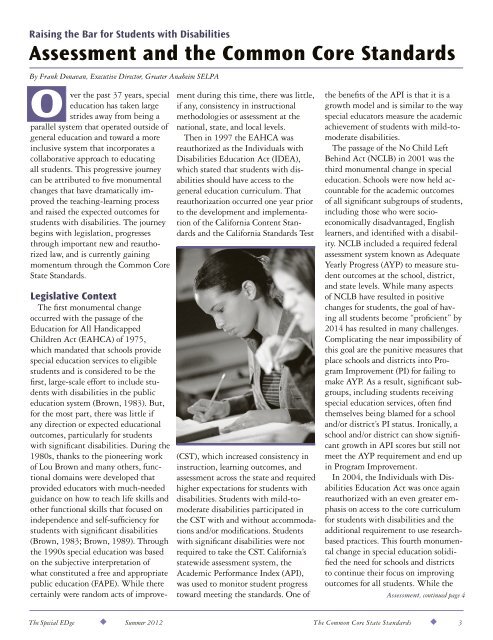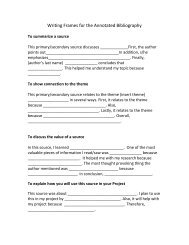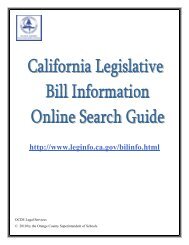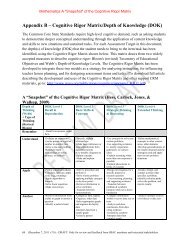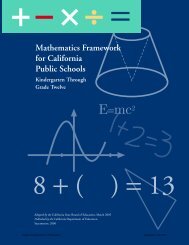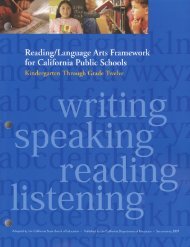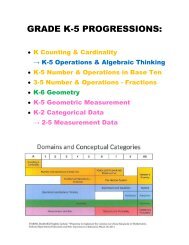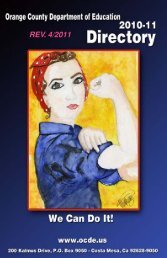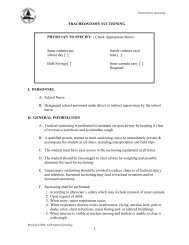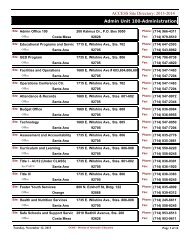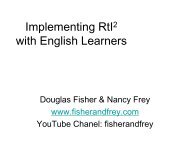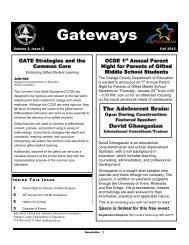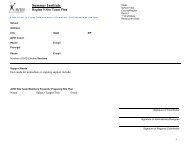The Promise and the Peril for Students with Disabilities - CalSTAT
The Promise and the Peril for Students with Disabilities - CalSTAT
The Promise and the Peril for Students with Disabilities - CalSTAT
You also want an ePaper? Increase the reach of your titles
YUMPU automatically turns print PDFs into web optimized ePapers that Google loves.
Raising <strong>the</strong> Bar <strong>for</strong> <strong>Students</strong> <strong>with</strong> <strong>Disabilities</strong><br />
Assessment <strong>and</strong> <strong>the</strong> Common Core St<strong>and</strong>ards<br />
By Frank Donavan, Executive Director, Greater Anaheim SELPA<br />
O<br />
ver <strong>the</strong> past 37 years, special ment during this time, <strong>the</strong>re was little,<br />
education has taken large if any, consistency in instructional<br />
strides away from being a methodologies or assessment at <strong>the</strong><br />
parallel system that operated outside of national, state, <strong>and</strong> local levels.<br />
general education <strong>and</strong> toward a more <strong>The</strong>n in 1997 <strong>the</strong> EAHCA was<br />
inclusive system that incorporates a reauthorized as <strong>the</strong> Individuals <strong>with</strong><br />
collaborative approach to educating <strong>Disabilities</strong> Education Act (IDEA),<br />
all students. This progressive journey which stated that students <strong>with</strong> disabilities<br />
should have access to <strong>the</strong><br />
can be attributed to five monumental<br />
changes that have dramatically improved<br />
<strong>the</strong> teaching-learning process reauthorization occurred one year prior<br />
general education curriculum. That<br />
<strong>and</strong> raised <strong>the</strong> expected outcomes <strong>for</strong> to <strong>the</strong> development <strong>and</strong> implementation<br />
of <strong>the</strong> Cali<strong>for</strong>nia Content Stan-<br />
students <strong>with</strong> disabilities. <strong>The</strong> journey<br />
begins <strong>with</strong> legislation, progresses dards <strong>and</strong> <strong>the</strong> Cali<strong>for</strong>nia St<strong>and</strong>ards Test<br />
through important new <strong>and</strong> reauthorized<br />
law, <strong>and</strong> is currently gaining<br />
momentum through <strong>the</strong> Common Core<br />
State St<strong>and</strong>ards.<br />
Legislative Context<br />
<strong>The</strong> first monumental change<br />
occurred <strong>with</strong> <strong>the</strong> passage of <strong>the</strong><br />
Education <strong>for</strong> All H<strong>and</strong>icapped<br />
Children Act (EAHCA) of 1975,<br />
which m<strong>and</strong>ated that schools provide<br />
special education services to eligible<br />
students <strong>and</strong> is considered to be <strong>the</strong><br />
first, large-scale ef<strong>for</strong>t to include students<br />
<strong>with</strong> disabilities in <strong>the</strong> public<br />
education system (Brown, 1983). But,<br />
<strong>for</strong> <strong>the</strong> most part, <strong>the</strong>re was little if<br />
any direction or expected educational<br />
outcomes, particularly <strong>for</strong> students<br />
<strong>with</strong> significant disabilities. During <strong>the</strong><br />
1980s, thanks to <strong>the</strong> pioneering work<br />
of Lou Brown <strong>and</strong> many o<strong>the</strong>rs, functional<br />
domains were developed that<br />
provided educators <strong>with</strong> much-needed<br />
guidance on how to teach life skills <strong>and</strong><br />
o<strong>the</strong>r functional skills that focused on<br />
independence <strong>and</strong> self-sufficiency <strong>for</strong><br />
students <strong>with</strong> significant disabilities<br />
(Brown, 1983; Brown, 1989). Through<br />
<strong>the</strong> 1990s special education was based<br />
on <strong>the</strong> subjective interpretation of<br />
what constituted a free <strong>and</strong> appropriate<br />
public education (FAPE). While <strong>the</strong>re<br />
certainly were r<strong>and</strong>om acts of improve-<br />
<strong>the</strong> benefits of <strong>the</strong> API is that it is a<br />
growth model <strong>and</strong> is similar to <strong>the</strong> way<br />
special educators measure <strong>the</strong> academic<br />
achievement of students <strong>with</strong> mild-tomoderate<br />
disabilities.<br />
<strong>The</strong> passage of <strong>the</strong> No Child Left<br />
Behind Act (NCLB) in 2001 was <strong>the</strong><br />
third monumental change in special<br />
education. Schools were now held accountable<br />
<strong>for</strong> <strong>the</strong> academic outcomes<br />
of all significant subgroups of students,<br />
including those who were socioeconomically<br />
disadvantaged, English<br />
learners, <strong>and</strong> identified <strong>with</strong> a disability.<br />
NCLB included a required federal<br />
assessment system known as Adequate<br />
Yearly Progress (AYP) to measure student<br />
outcomes at <strong>the</strong> school, district,<br />
<strong>and</strong> state levels. While many aspects<br />
of NCLB have resulted in positive<br />
changes <strong>for</strong> students, <strong>the</strong> goal of having<br />
all students become “proficient” by<br />
2014 has resulted in many challenges.<br />
Complicating <strong>the</strong> near impossibility of<br />
this goal are <strong>the</strong> punitive measures that<br />
place schools <strong>and</strong> districts into Program<br />
Improvement (PI) <strong>for</strong> failing to<br />
make AYP. As a result, significant subgroups,<br />
including students receiving<br />
special education services, often find<br />
<strong>the</strong>mselves being blamed <strong>for</strong> a school<br />
<strong>and</strong>/or district’s PI status. Ironically, a<br />
school <strong>and</strong>/or district can show significant<br />
growth in API scores but still not<br />
meet <strong>the</strong> AYP requirement <strong>and</strong> end up<br />
in Program Improvement.<br />
In 2004, <strong>the</strong> Individuals <strong>with</strong> <strong>Disabilities</strong><br />
Education Act was once again<br />
reauthorized <strong>with</strong> an even greater emphasis<br />
on access to <strong>the</strong> core curriculum<br />
<strong>for</strong> students <strong>with</strong> disabilities <strong>and</strong> <strong>the</strong><br />
additional requirement to use researchbased<br />
practices. This fourth monumental<br />
change in special education solidified<br />
<strong>the</strong> need <strong>for</strong> schools <strong>and</strong> districts<br />
to continue <strong>the</strong>ir focus on improving<br />
outcomes <strong>for</strong> all students. While <strong>the</strong><br />
(CST), which increased consistency in<br />
instruction, learning outcomes, <strong>and</strong><br />
assessment across <strong>the</strong> state <strong>and</strong> required<br />
higher expectations <strong>for</strong> students <strong>with</strong><br />
disabilities. <strong>Students</strong> <strong>with</strong> mild-tomoderate<br />
disabilities participated in<br />
<strong>the</strong> CST <strong>with</strong> <strong>and</strong> <strong>with</strong>out accommodations<br />
<strong>and</strong>/or modifications. <strong>Students</strong><br />
<strong>with</strong> significant disabilities were not<br />
required to take <strong>the</strong> CST. Cali<strong>for</strong>nia’s<br />
statewide assessment system, <strong>the</strong><br />
Academic Per<strong>for</strong>mance Index (API),<br />
was used to monitor student progress<br />
toward meeting <strong>the</strong> st<strong>and</strong>ards. One of Assessment, continued page 4<br />
<strong>The</strong> Special EDge u Summer 2012 <strong>The</strong> Common Core State St<strong>and</strong>ards u 3


